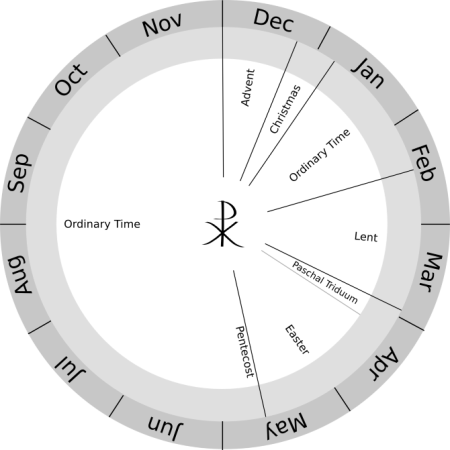Today is February 2nd, which means (besides the annual showing of Groundhog Day) that it's the Feast of the Presentation, better known as Candlemas. Candlemas is actually the holiday behind Groundhog Day, in that there was an old folk tradition that a sunny Candlemas meant a long winter, but that's another story. More to the point, Candlemas is a turning point in the year. If you pray the four seasonal Marian antiphons, today marks the first day of a new season. If you don't pray them, or don't know what they are, read on. The liturgical calendar. Exact dates (especially for Lent and Easter) vary by year.
The liturgical calendar. Exact dates (especially for Lent and Easter) vary by year.
The four Marian antiphons are traditional hymns prayed or sung before bed, a sort of goodnight to the Blessed Mother. There's a different one for each season. Here's the Latin and the standard English, and a link so that you can hear it in simple chant (as sung by the Benedictine Monks of Santo Domingo de Silos).
I. Alma Redemptoris Mater
When? Advent and Christmastide (and a chunk of Ordinary Time I). It is prayed from the beginning of Advent until Candlemas (today, February 2nd).
How does it go?
| Latin | English |
| Alma Redemptoris Mater, quae pervia caeli porta manes et stella maris, succurre cadenti, surgere qui curat, populo: tu quae genuisti, natura mirante, tuum sanctum genitorem, Virgo prius, ac posterius, Gabrielis ab ore sumens illud ave, peccatorum miserere. |
Loving Mother of the Redeemer, gate of heaven, star of the sea, assist your people who have fallen yet strive to rise again. To the wonderment of nature you bore your Creator, yet remained a virgin after as before. You who received Gabriel's joyful greeting, have pity on us poor sinners. |
What does it sound like? Like this.
II. Ave Regina Caelorum
When? Lent (and a chunk of Ordinary Time I). We start praying this today (February 2nd) and will pray it until the Easter Vigil.
How does it go?
| Latin | English |
| Ave regina caelorum, ave domina angelorum: salve radix, salve porta, ex qua mundo lux est orta: Gaude Virgo, gloriosa, super omnes speciosa, |
Hail, Queen of Heaven; hail, Mistress of the Angels; hail, root [of Jesse]; hail, the gate through which the Light rose over the earth. Rejoice, Virgin most renowned |
What does it sound like? Like this.
III. Regina Caeli
When? Eastertime. It's prayed from the Easter Vigil until Pentecost.
How does it go?
| Latin | English |
| Regina caeli, laetare, alleluia; quia quem meruisti portare, alleluia; resurrexit sicut dixit, alleluia; ora pro nobis Deum, alleluia. |
Queen of heaven, rejoice, alleluia; for He whom thou was chosen to bear, alleluia; has risen as He said, alleluia; pray for us to God, alleluia. |
What does it sound like? Like this.
IV. Salve Regina
When? Ordinary Time II. It's prayed from Pentecost until the first Sunday in Advent.
How does it go?
| Latin | English |
| Salve Regina, mater misericordiae, vita, dulcedo, et spes nostra salve. Ad te clamamus, exules filii Evae. Ad te suspiramus, gementes et flentes, in hac lacrimarum valle. Eia ergo, advocate nostra, illos tuos misericordes oculos, ad nos converte. Et Jesum, benedictum fructum ventris tui, nobis post hoc exsilium ostende.O Clemens, o pia, o dulcis virgo Maria. |
Hail holy Queen, mother of mercy, our life, our sweetness, and our hope. To thee do we cry, poor banished children of Eve. To thee do we send up our sighs, mourning and weeping in this valley of tears. Turn then, most gracious advocate, thine eyes of mercy towards us, and after this, our exile, show unto us the blessed fruit of thy womb, Jesus.O clement, o loving, o sweet Virgin Mary. |
What does it sound like? Like this.
If you're not in the habit of praying or chanting these antiphons, today's a great day to start, since it's the beginning of a new season. It's a good way of drawing closer to Mary, of keeping in sync with the liturgical season, and of ending each night on the right note.